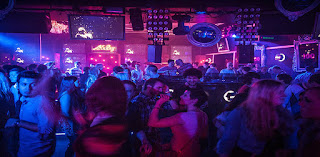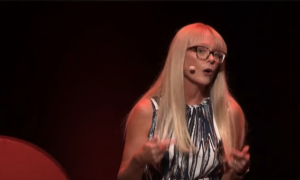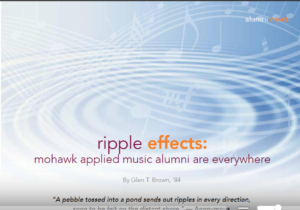By Glen Brown
Technology is transforming the way we find, choose, and consume music so fast, it’s mind-boggling. For Hamilton to become a leader in music, one way will be to find the connection between our great music, our entertainment venues, and our brilliant technologists. And it will have to be very, very soon.
Cities are the power hubs of today’s civilization, and the same will be true tomorrow. They allow for quick transfer of ideas, capital, and people. Talent can be effectively coordinated, and markets can become more specialized. A hundred years ago, less than 10% of the world’s population lived in cities. Now it’s more than half.
In the olden days, a city was made great because of its geographical location, ie. It had a deep water port, or was at a trading crossroads. But now and in the coming years, cities will become great in new ways. And if these new ways to prosperity are ignored, opportunity will be lost and many good things with it.
Nobody is arguing that big data will not continue to develop. As we place sensors in more and more places, as we connect to new types of information sources, and as we create innovative ways to get computers to mine the data, we will have a vast commodity that holds great opportunity.
In the olden days a discovery of a new ore deposit ensured wealth. But in the days to come the wealthiest opportunities are built on the mountain of new data that are about to be produced. Hail to those cities that can put it good use. In all likelihood, Hamilton will have only a couple of possible ways to become a world-class city in this respect.
Maybe Hamilton is a potential “domain hub” for the music industry in Canada.
Domain hubs are cities and regions of the world that hold special knowledge and experience. For example, London and New York are financial services hubs. Detroit is an automotive research hub. The world’s domain hubs in the future will be cities that assert their power by creatively using the vast amount of big data that is out there and applying it to their area of specialty.
Combining this vision with coordination and cooperation is key. Through our recent Music Strategy survey it has become clear that our local music venues have got a lot to learn and more to gain by cooperating. In so many ways we are just like so many beginners, like kids in a sandbox, when it comes to audience engagement and development. In so many ways we are clinging to old models.
But who’s to say that our local venues couldn’t cooperate and team up with technical firms to create the world’s first virtual live music hub? Who’s to say that our venues won’t be the group to spearhead the complete digitalization of the music performance industry in Canada?
Hamilton: Centre of Canadian musical innovation for the next century.
Hamilton is no alpha city like Tokyo, Shanghai, London or New York. But there’s every reason to believe that Hamilton can become a beta city, dominating the region in a particular area of innovation, and serving as a leader in the region.
In order to move ahead like this, we need our infrastructure to be finely developed, reliable, complete and available to the masses. If we can’t even find out when the next HSR bus is arriving it’s a sign that our infrastructure is broken, or needs focusing. Or, more likely, there are political forces that keep it from developing properly. Make no mistake, in the future where data is king, the masses, to be happy, will need to get the information they want exactly when they want it. And we need to find some new connections between the music, the venues, and the technology business sectorsDo we have the political will and the vision?
Openness of government, ease of doing business, and fostering welcoming attitudes to receive people from all cultures and all walks of life is the other component of developing into a significant urban centre to move ahead as a leader. Russia is proving itself completely backward in this regard as it tries to muzzle its media and crank out propaganda to the masses. Yet, other countries are seizing the moment. For example in May 2014, Doha in Qatar opened a $15 billion airport it hopes will compete for the title of “world’s busiest airport.”But the best example is Estonia, which has basically made itself great by riding on a river of technological advance. In 1992 the country was in dire straits, economically weakened after the Soviet Union collapsed. But now, after 30 years of economic and technological transformation and innovation, fostered by persistent, stern and astute political vision, Estonia ranks first of 159 countries in the
State of World Liberty Index. It established internet voting in 2005 and is moving into a place of worldwide prominence as an “e-state” where all government functions and resources are freely accessible to online users. It exports its technology in creative ways, fosters quick and easy development of new business at home and abroad, and spends generous amounts of its national income on education. Children begin to learn coding in primary school. Estonia is a member of the European Union and has basically re-invented itself as a leader in internet security and technological prowess. By streamlining the process for becoming a corporation able to trade in the EU bloc, Estonia allows companies to begin doing business in the EU with minimum hassle while other countries present a mess of red tape and bureaucratic hassle.
|
| Hamad International Airpot, Doha, Qatar |
Big data, wireless connectivity, sensor technology, video innovation and real-time information will undoubtedly continue to affect the presentation and delivery of music to the masses. Hamilton’s opportunity lies in creating something new and brilliant within this hotbed of possibility.Our present music consumption tools such as Spotify or an iPhone are barely scratching the surface. The big breakthroughs are yet to come!
For a moment let’s go on a fantastic journey into the mind of a typical Millennial:
“Why should I have to touch my smartphone to choose music? I want an app that chooses music based on my heartbeat and the temperature of my palms!”
So I imagine someone will learn how to make use of the data gathered by Fit-bands, and use it to pick songs from the user’s playlists. And people will buy it.
Let’s keep dreaming for a bit more. Think about the ultimate musical experience. What would your “ultimate music app” do for you, in your wildest dreams?…
The ultimate app would enable a user to call up whatever music they feel like listening to at any given moment, and it will be super easy. Perhaps it even wouldn’t require any effort or thought at all. Maybe your “ultimate music app” will select music for you based on your biometrics!
The days of carefully selecting your vinyl, removing it from the sleeve, carefully queueing it up on the direct drive and dropping the needle? Gone forever my friend. Too much fucking trouble!
|
| Vinyl. Will anyone bother 20 years from now? |
But the big possibilities for innovation are in the realm of social gatherings, where music is king. Picture this: You and your friends go to the music/dance venue in your neighbourhood. You’re all wearing your Fit bands. You’ve opted in to the public sharing of your bio data. The newly developed “Big Data music venue app” will aggregate the bio data from everyone in the room, and translate their heartbeats and palm temperatures into a music “mood quotient” if you will – a numerical average of the crowd’s musical desires.
The music venue app will choose the artist and the song of the moment which will reflect the mood of the majority of people at that moment, in real time. Maybe you’ll see information about who’s playing on the giant screen.As a musician, wouldn’t you want your music to be available on that platform? Your music would be tagged in the database according to the mood it reflects!
The music venue app may be designed to search and access any group of musical artists who have made their music available on the platform. Or in another twist where musicians are put out of work, the app may just play music and beats all by itself, basically by inventing an algorithmically-designed soundscape that morphs, ebbs and flows with the feeling of the room.
I admit, that last example feels a little creepy.
But let’s get ready for it: The music technology of the future will be connected to physical sensors that are placed within the audience. The audience has chosen to “wear” them. They go into a room where the music is as much a part of the room as is the furniture and the bartender, or what is showing on the big screens.
|
| Nike Fuel Band, for example |
What about money? The monetization comes in when people get to choose their music.
Think of this: How much would one person be willing to pay to alter the mood in the room by overriding the “machine choice” of music? How could a group of friends bid cash to dominate the music of the moment?
In the olden days they called it a Juke Box.
What about excitement and spur-of-the-moment randomness? “Music selection overrides are disabled for the next 10 minutes.”
On a different train of thought, music would be used to liven up or calm down a room, based on the needs of the moment. This is already a reality for many retail outlets who subscribe to music services based on their targeted customer profiles. But we still have yet to see how, in a live entertainment venue, the music/mood data from one room could be reported and shared with other rooms in the area, or anywhere else in the world!
Stay with me here. What about new camera and drone technology? Virtual tourism, anyone?
What kind of virtual visits would be possible, via a remotely controlled drone-based micro camera? Your visit to the digitized venue could also include “virtual guests” who are controlling drone-based cameras that hover silently around the room. Who knows who you could meet in such a place?
|
| DJI Phantom 3 Professional Quadcopter Drone |
Or, from the other side, if you didn’t feel like going out, you could stay home in your own virtual room and you and your friends could visit a disco in any given city you wanted to. You could hover in the centre of the dance floor, or move across the front of the stage with your camera-eye. You could attend an international music festival and be in a virtual balcony seat!
You see? We’ve had glimpses of what the digital age can offer us. We’ve already seen how the cable-strung cameras float and zoom over the Super Bowl players. It’s not science fiction. We’re just waiting for someone to make this work for music.
The future is ours if we want it. Adapt or perish. Let us entertain the people.One day soon our music will be out there where the world is brand new and all things are possible.
———————————-
Bibliography
Industries of the Future by Alec Ross. Get it here on Amazon.





